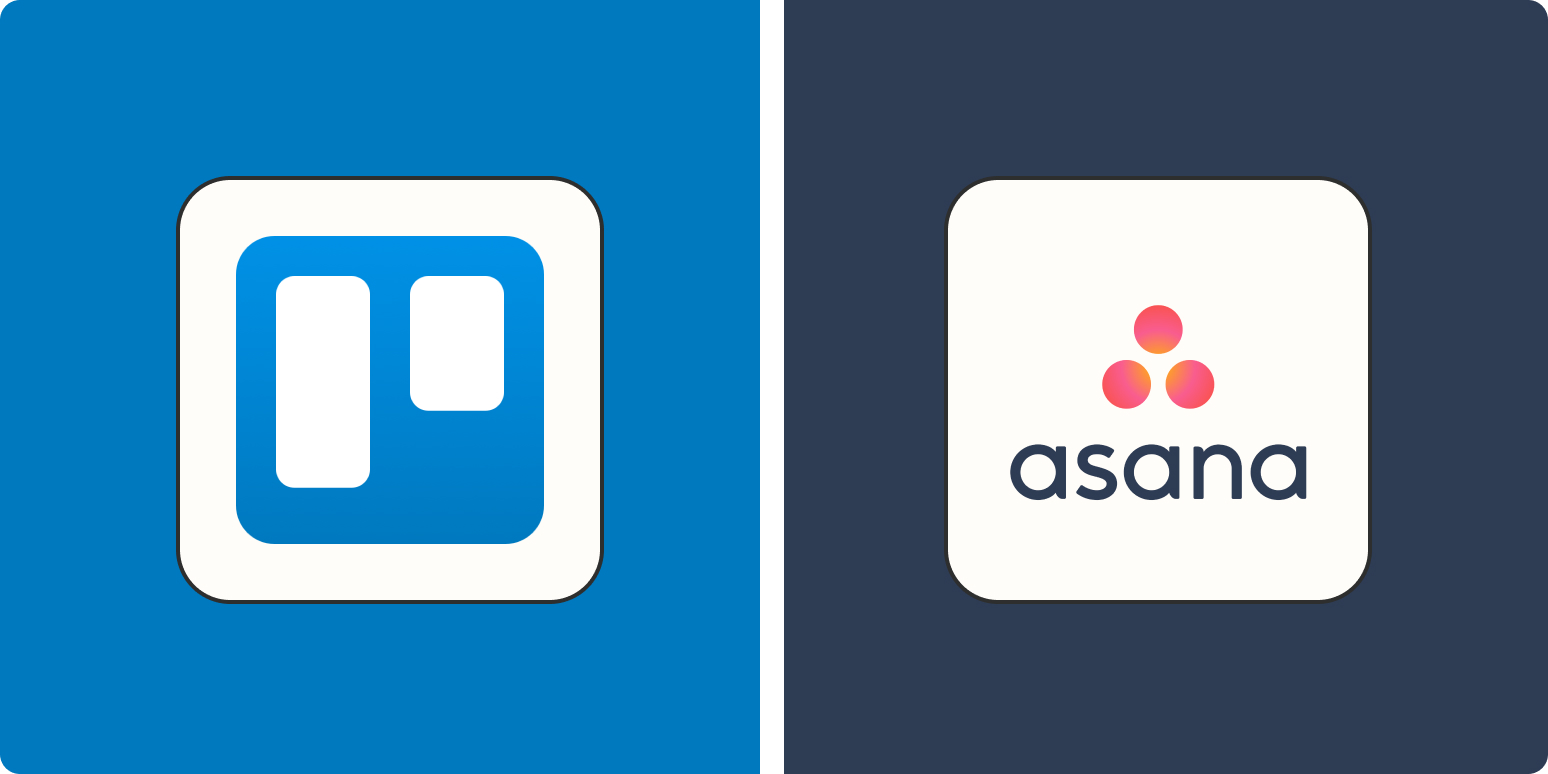If you’ve only heard of two project management apps, it’s probably Trello and Asana. Both for personal use and for collaboration between people and even across teams, Trello and Asana are two of the most popular apps for corralling large projects and getting stuff done.
Connect your project management software to your other apps
Trello and Asana both do the same thing—help manage your projects—but they go about it differently. When it comes down to it, Trello is a Kanban tool, and everything else is gravy. Asana is a more traditional project management app that’s a bit better suited for team projects.
I spent some time testing both apps, so keep reading to see how they stack up.
Trello vs. Asana at a glance
|
Trello |
Asana |
|
|---|---|---|
|
Free features |
⭐⭐⭐⭐ Only Kanban (with a limit of 10 boards), but you’ll get access to automation and unlimited Power-Ups |
⭐⭐⭐ You get more project views, but you’ll have to upgrade for things like automated workflows; limited to 15 users |
|
Project views |
⭐⭐⭐⭐ Free and Standard plans: Kanban boards Premium and Enterprise plans: Calendar, Timeline (Gantt chart), Table, Map, and Dashboard views |
⭐⭐⭐⭐ Free plan: Kanban, Calendar, and Table views Premium and Business plans: Timeline (Gantt chart) view |
|
Templates |
⭐⭐ Large template library, but each template offers the same basic setup with different headers |
⭐⭐⭐⭐ Large template library, and each template includes a basic setup, pre-set automation workflows (where applicable), and a list of recommended app integrations |
|
Team management |
⭐⭐ You can’t assign tasks to individual people; tasks have “Members” that are tagged and notified about progress. |
⭐⭐⭐⭐⭐ Users can assign tasks to individual members, and tasks from different projects are automatically gathered in one place. |
Trello is better for individuals; Asana is better for larger teams
Yes, I know—Trello can absolutely be used by teams. And, in fact, there’s no limit on the number of members in a workspace, even for free plans. But there are some really big limitations that make it tough for big teams. The big one: you can’t really assign tasks to individual people. Instead, tasks have “members” that are tagged and notified about progress. In theory, if a task only had one member, you could consider that an “assignment,” but it’s not the best system.
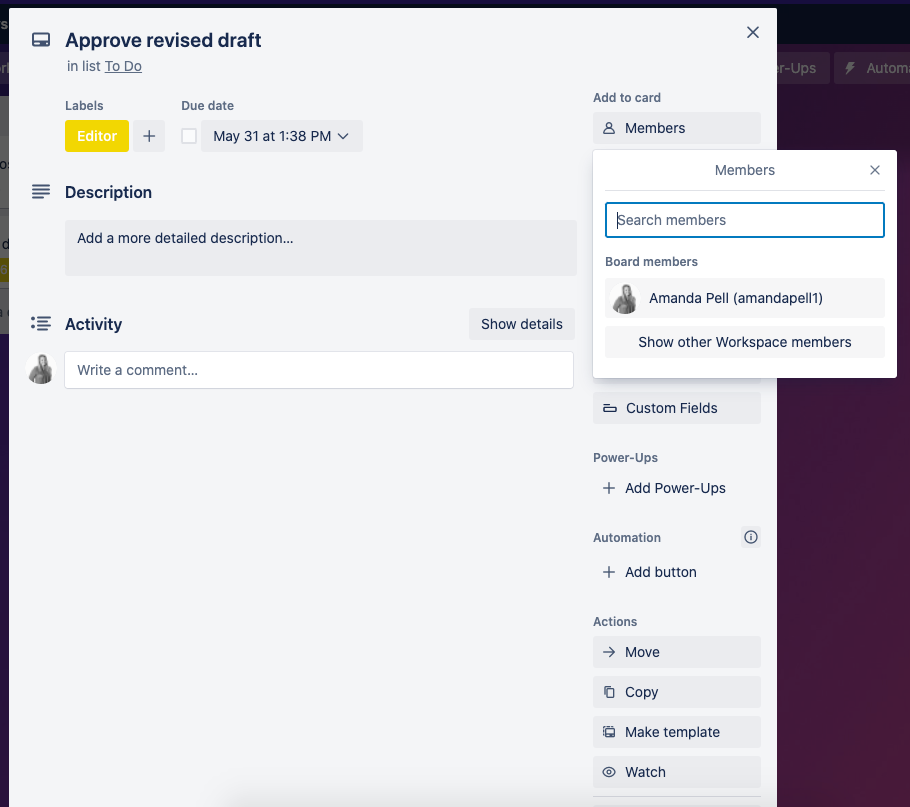
Asana lets you assign tasks, and it also does a better job of allowing project managers to oversee multiple projects simultaneously without having to keep separate tabs open for each. For each individual, the “My Priorities” widget on the Homepage sorts tasks into “Upcoming,” “Overdue,” and “Completed.” These tasks are collated from all of the user’s projects, providing a master list of tasks, so users don’t have to toggle between project pages to keep track of to-dos.
Plus, Asana has reporting features that are important for larger teams that Trello lacks—but more on that later.
Trello is the Kanban app, but Asana has a more professional vibe
Trello’s primary UI is a no-nonsense, drag-and-drop Kanban board. Within each board, you can create lists, and within those lists, you can create task cards that can be dragged and dropped between lists as you progress through your project.

While there is a Kanban view in Asana, it’s not the primary focus of the app, so it lacks the polish and satisfying Kanban feel that Trello has. Moving tasks from one list to another in Trello is legitimately fun. In Asana, it feels much more buttoned up.
This buttoned-up feel continues on the main dashboard/HQ. On Trello, the main page where you can see all of your boards, workspaces, and members, is…fine. It’ll get the job done, but the lack of clear section headers and unnecessarily large task cards feels messy.
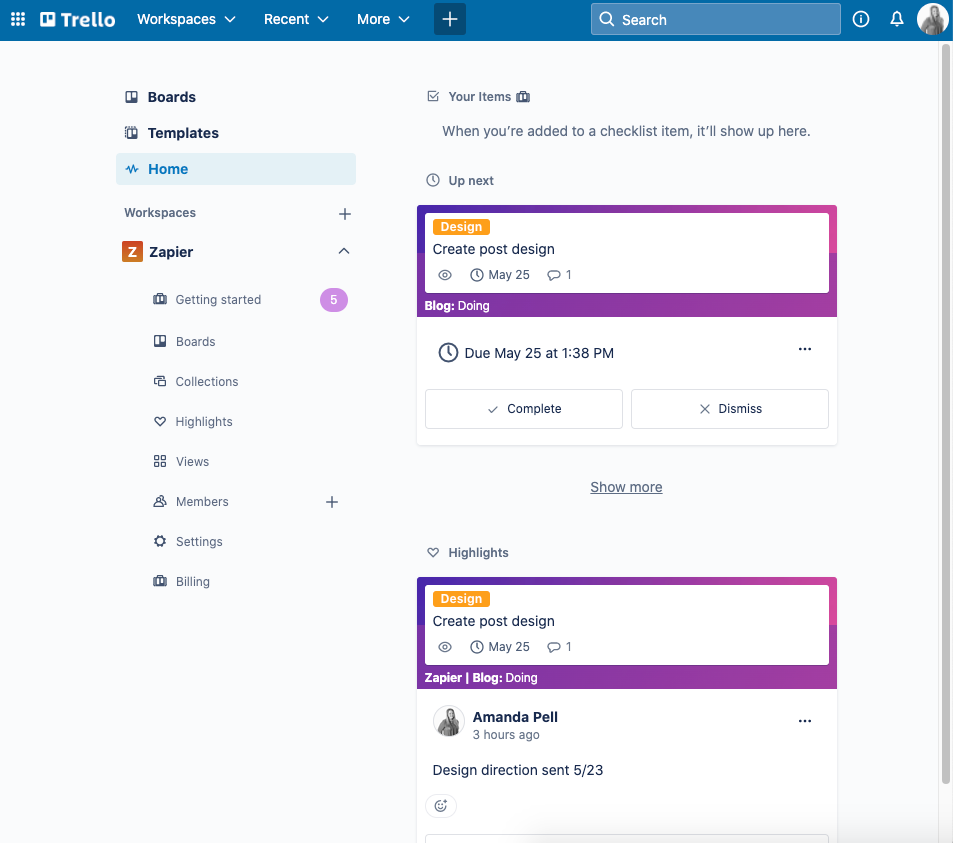
Along the same lines: if you’re in list or calendar views and you click to open up a task, Trello will open a new tab to take you back to the Kanban board first, which is a little annoying.
Asana’s homepage is significantly more organized and offers a better top-line summary of a user’s projects and tasks.
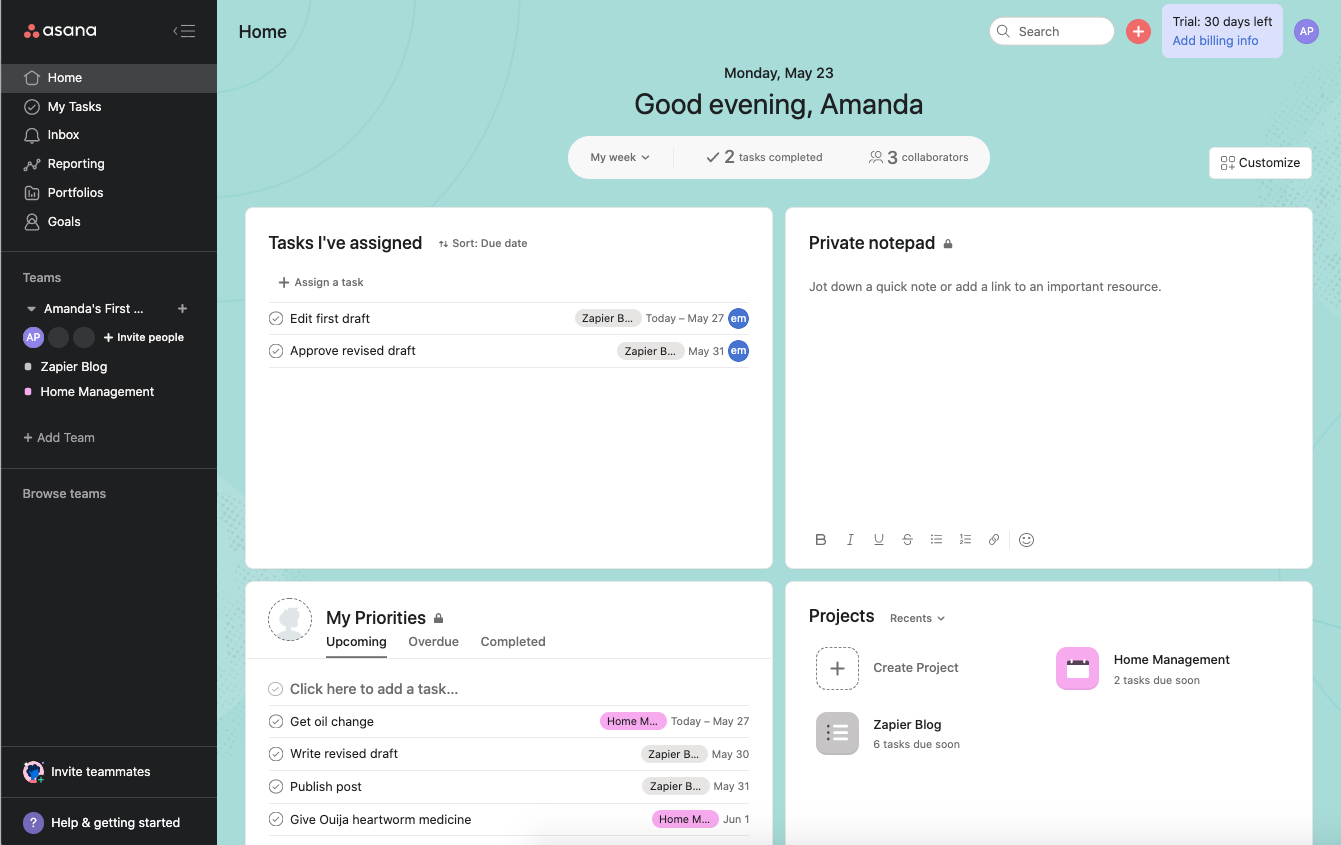
Both apps offer a variety of project views—mostly the same ones, as long as you pay for Trello—but Asana is undeniably the more polished of the two tools.
Asana’s templates are much more in-depth
Trello’s templates really aren’t all that useful—they’re all formatted the same (since all Kanban boards have the same structure), just with different titles for each list and a few task cards pre-loaded. Since you’ll have to delete each template card or replace all of the existing info with your own, these templates seem to create more work than they save.
The templates Asana provides are much more robust than Trello’s. Each template suggests the best primary view (Calendar, Board, List, or Timeline) for different project types, and pairs the template with suggested automation workflows and app integrations. They also offer templates from specific brands that use Asana, so you can set up your projects the same way. For example, the template below allows users to see how ClassPass manages its marketing campaigns.
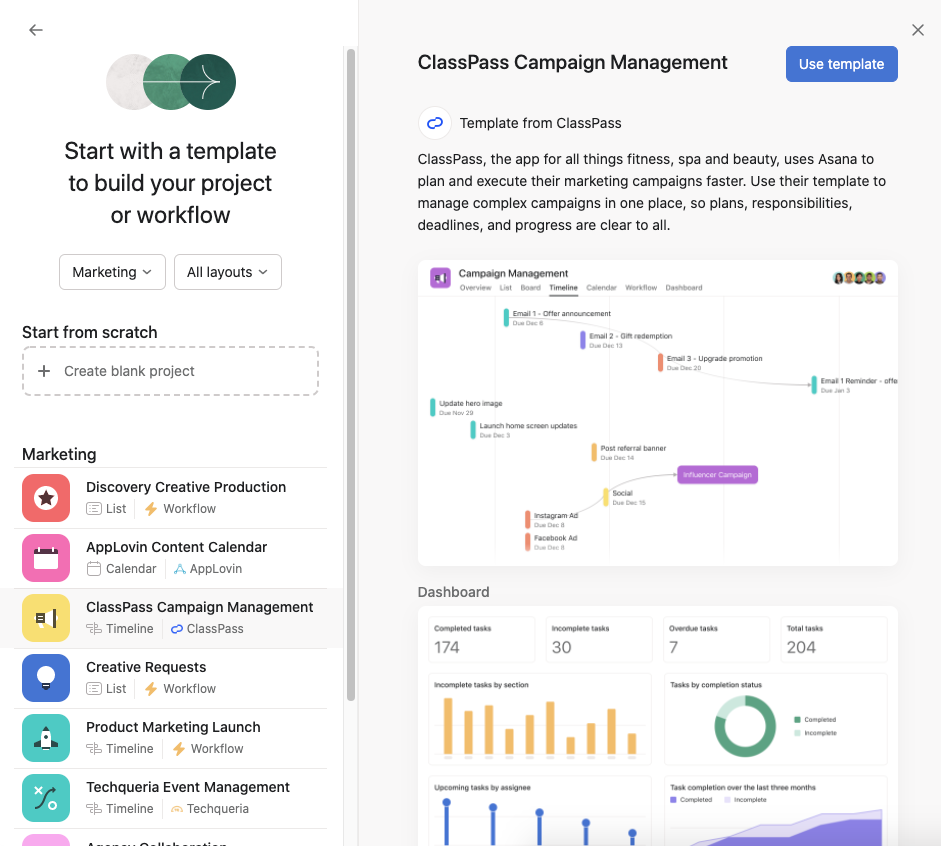
Trello has better automation options at lower pricing tiers
Trello allows free users up to 250 automation workflow command runs per month (and the $5/month plan bumps that up to 1,000). Those automations kick off whenever there are project actions—for example, when cards are moved between lists or tasks are completed. Another cool feature: Trello users can set up buttons on cards and boards to perform automation sequences. So that means you can trigger your own automations for one-off tasks.

Asana users have to upgrade to implement automation triggers at all. Even Premium users on Asana are limited to a pre-set menu of rules: custom and dynamic automation rules are reserved for Business users ($24.99/user/month). Once you get to the Business plan level, though, Asana’s automations are about as capable as those offered by Trello’s Enterprise plan.
The good news: both apps integrate with Zapier, which means you can connect them with the other tools in your tech stack to automate your cross-app workflows.
Zapier is an automation tool that connects your apps and moves information between them, so you can focus on what matters most. Check out this Zapier demo to learn more about how it works.
Asana has better reporting capabilities
Premium Asana users have access to a reporting dashboard that can measure a wide range of metrics using custom fields. For example, if you add a custom field to your tasks for cost, you can pull a report on costs per project or tasks per cost range.

Trello’s built-in reports, on the other hand, are extremely bare-bones even for paid users, consisting of “cards per list,” “cards per member,” “cards per label,” and “cards per due date.” You can definitely use Power-Ups for reporting in Trello, but you’ll want to be sure an integration exists to produce the reports you need. It’s also trickier to set up if you’re a beginner who isn’t sure yet what they should be measuring.
Trello vs. Asana: how to make your choice
So here’s the final rundown:
Trello is better for:
Asana is better for:
-
Larger teams and organizations
-
Teams that need a variety of templates and reporting options
-
Individuals who want more views on a free plan
Still undecided? If none of the factors above are tie-breakers for you, take a look at our guides on creative ways to use Trello and how these companies use Asana to manage different projects and see if either set of examples inspires you.
This article was originally published in July 2019 by Marshall Gunnell.
Need Any Technology Assistance? Call Pursho @ 0731-6725516

